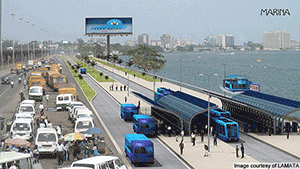Millions encounter transport difficulties daily in Lagos, as happens in other major cities the world over. Governor Babatude Fashola has introduced a quartet of solutions that, if fully implemented, will ease the problems.
But, as Special Correspondent, SAM NWOKORO, reports, the solutions may not endure unless the underlying factors are tackled.
Proposed Lagos light rail transport system (right).
Former Governor Bola Tinubu rehabilitated some roads in Lagos State, but that did not resolve all the trouble with movement.
This led to his successor, Babatunde Fashola, taking up transportation as a priority, both to make life easy for residents and to ensure free movement of goods and services to generate revenue.
Mega city status
Fashola launched the mega city project in 2007 and began to invest in transport infrastructure, focusing on four systems: road, water, rail and air.
He realised that as investment expands in Lagos with the take off of the Lekki Free Trade Zone, the domestic wing of the Murtala Mohammed Airport may not cope with shuttle traffic in and out of Lagos, and began the Lekki Airport project.
Money was pumped into the ferry system as well as in dredging smaller bodies of water and building more jetties.
New roads have been built and existing ones rehabilitated, dualised and electrified.
Yet, there is traffic gridlock on most roads in Lagos. The Apapa axis is of the most agonising nightmare. The snarling traffic on the Apapa to Oshodi stretch is compounded by the endless construction work on the federal road for the past two years.
The deluge of heavy duty trucks and inflammable tankers loaded with petroleum products waste hours as drivers struggle to meander in and out of clogged lanes.
A commuter, Dele Ogundele, lamented recently that “this is the worst gridlock I have ever been trapped in since my 20 years of living in Lagos.”
Fashola blames the Nigerian National Petroleum Corporation (NNPC) for concentrating fuel tank farms on Apapa, causing stampede by lifters and compounding vehicular and human mobility.
“Why can’t the NNPC supply fuel products to Mosimi and other depots on the outskirts?” he wondered.
How soon will the agony of long queues in the whole routes in the city end? Will the first phase of the light rail take off as promised by Fashola before his tenure ends in May 2015?
Are the waterways providing adequate mass transit? When will the Lekki Airport be completed? Can the deadline of 2015 and 2017 for commissioning public/private projects (PPPs) be realised?
The answers to these and other questions will determine how soon the transport quagmire will be resolved.
Historical magnets
Lagos attracts new residents nearly everyday, expanding its population. Year in, year out, a few thousand more move in. It is not the fault of the state government. Lagos was once Nigeria’s capital, which drew all and sundry from all parts of the country looking for a better life.
Although the capital was moved to Abuja in 1992, Lagos remains the commercial hub, with the same effect of drawing new residents.
Foreigners who come to Nigeria also make Lagos their first choice of stay.
Beginning of remedy
The administration of Lateef Jakande began to revamp the transport system in 1980 with the introduction of ferry services from the Marina on Lagos Island to Apapa and Mile 2, and from Ebute Ero on Lagos Island to Ikorodu and Epe.
But Jakande’s plan to introduce an intra-city light rail did not get off the ground.
Before the 1980s, the government ran the Lagos Metropolitan Transport Service (LMTS), which became the Lagos State Transport Corporation (LSTC).
It was complemented by private transport companies, such as Benson Transport, and molue and danfo operators.
The public road and water transport fleet had depreciated by 1995. Thus when democracy returned in 1999, the government had little left on mass transit.
The Tinubu administration (1999-2007) rehabilitated some urban roads. But much of the road infrastructure was put in place by Fashola.
Highlights of Fashola’s reform
Fashola has rehabilitated several roads, re-organised motor parks, beautified highways, built the 10-lane tolled Lagos to Epe highway, established the popular bus rapid transit (BRT), and ensured proper identification of transport union officials.
Fashola embarked on an integrated road, rail, sea and air transport infrastructure development. His Transport Commissioner, Kayode Opeifa, said the transport system envisages leveraging on all available natural endowments to ease the movement of people.
The government created agencies such as the Lagos State Transport Management Authority (LASTMA), to oversee road transport; Lagos Ferry Service to oversee water transport; state traffic radio to provide traffic information; BRT to move people.
The fourth Mainland Bridge to ease traffic away from central Lagos is expected to be completed by 2017.
Moving on water
The state has introduced a scheme to enable ferry operators buy larger boats as the present ones are of small capacity.
One resident who patronises the ferry service said “the boats are providing relief, but the government should ensure that operators buy new boats, not second hand boats.
“The sound of the engines of some of the current boats can make you fear, unless you are used to travelling on them.”
Light rail take off
The most ambitious of all investments in public transportation is the 10-lane highway from Lagos to Badagry with a light rail corridor.
The project is designed to ease heavy human and cargo traffic from major trading conurbations like Alaba International Market, ASPAMDA, Trade Fair International Market and other west coast markets in Benin Republic and Ghana.
The first phase (Lagos-Okokomaiko) is expected to be completed before Fashola leaves office in May 2015.
The government recently obtained a $100 million loan from the International Development Association (IDA), an arm of the World Bank, to fund the project.
Recurring dichotomies
Lagos is hardly satisfied with the federal government’s input into its public transport system.
One resident, a newspaper distributor who did not want to be named, said “since independence, all the road and port developments have been in Lagos. So if the federal government does not build any other thing in Lagos, the state should improve on what it already has and let other parts of the country be like Lagos.
“Nigeria is growing and expanding, and Lagos is over populated already. So there is need for economic enhancing infrastructure in other parts of the country so that people can migrate and decongest Lagos.
“The way it is now, the traffic problem, molue problem, and the problems caused by LASTMA officials will continue.”
High costs, long waits
Patronage of ferry service is on the increase. The boats cruising from the Marina to Ikorodu are always filled to capacity.
But boats are few because of high cost, which ranges between N15 million to N20 million depending on capacity.
The same problem of funding is one of the reasons operators are not taking advantage of the LAGBUS scheme floated by the government to involve private companies in bus transit.
The result of all these is that commuters wait for long at bus stops, a situation compounded by the restriction on motor cycle and tricycle taxis.
A BRT passenger lamented that “before you didn’t wait long before the buses came, but now you rush. It is like the numbers have reduced.”
An official in Alausa disclosed that “the government planned to add at least 100 buses each year, but changed that policy in preference to kick-starting the partial use of the Marina-Okoko light rail project billed to take off next year.”
NRC puzzle
Another problem is the Nigerian Railway Corporation (NRC). In early June, pandemonium broke out at the Yaba terminus of NRC when thousands of commuters protested a fare hike because of new air-conditioned coaches.
The NRC charges N750 per seat for a journey of about one hour from Iddo to Ojokoro for the new coaches but retains N250 for the old coaches.
The commuters living on the outskirts who patronise the rail are mostly low income earners who cannot afford the new fare.
The new coaches are barely filled while the old ones overflow with its life-threatening passenger haul.
One commuter who gave his name as Shola, said “the NRC has become elitist. They bought the coaches to ease the rushing by passengers. But see what they are charging. This means every day, I will pay N1,500 going through and fro Ojokoro. How do I make it in a day?”
Another who ferries his bag load of crayfish to Oyingbo from Ojokoro urged the NRC not to bring “class” into their service. “If they don’t want us to ride in the new coach, let them bring in more of the old coaches so that we can at least have space.
“How can one stand from here in the train to a long distance even after paying N250.”
What to do
A commuter suggested that “the government has to reduce banks’ interest on loans meant for the transport sector. Why do our banks charge a uniform rate in a liberalised economy?
“Those building mass transit buses locally need to be encouraged. Also, the government has to make it compulsory for government establishments to buy locally made vehicles to save the huge money spent on importing vehicles.”
Another resident. Luke Iwuji, urged the government to continue to build more roads. “Opening more routes will make room for vehicles to divert and decongest the roads. Lagos should open up more areas and new roads.”













